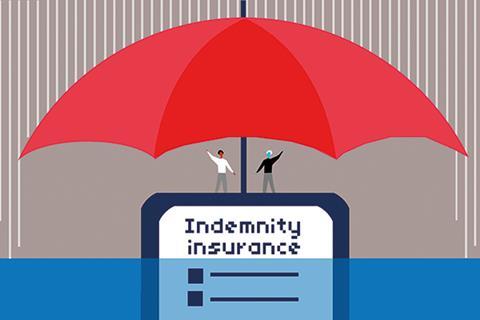Ryan Senior and Piers Winton from Paragon International discuss the upcoming professional indemnity insurance renewal and outline how to mitigate your risks


Industry commentators estimate that fewer than 100 firms close each year due to failing to secure professional indemnity (PI) insurance as required by the Solicitors Regulation Authority (SRA) Indemnity Insurance Rules. Contrast this number with the profession as a whole (9,562 as of January 2023), and it is clear that only a small proportion of firms are involved. Still, for those that are, the consequences to their professional and personal lives are immense.
Facing closure
There is a procedure in place to give the firm some time after the PI policy has expired to secure alternative cover. The incumbent insurer will provide the firm with an extension of cover called an extended policy period (EPP). The EPP lasts for 30 days, during which alternative cover can be sought. After the 30 days have elapsed, the firm enters into a cessation period (CP) of 60 days cover, during which the firm must close in an orderly fashion. In theory, this means a viable law firm can go to cessation in just 90 days, but it needn’t be that way.
In our experience, with appropriate preparation, even firms with challenging historical claims records can turn around their perceived performance by implementing risk and operational controls that address the causes of claims. If the actions taken are properly communicated to underwriters, we would seek to assure the incumbent or any new insurers that adverse performance issues have been identified, ring-fenced and rectification measures properly implemented.

Although insurers are guarded about disclosing their underwriting performance, it’s a poorly kept secret that firms placed into run-off collectively perform badly through a combination of adverse claims and unpaid premiums, so it’s in everyone’s best interest to find a workable solution.
The danger signs
Although there is no definitive model of a distressed PI risk, most commonly we see four recurring themes:
- high volume, small losses
- one-off large losses
- a distinct pattern of losses
- regulatory investigations.
You must act immediately if you feel your firm falls into one or more of these categories. Addressing the problem head-on and promptly engaging with insurers will give you a fighting chance to maintain your PI coverage.
High volume, small losses
High administration costs combined with the inability to lay off smaller claims against their reinsurance protections mean that smaller claims impact insurers most, a death by a thousand cuts. Even if the financial impact is minimal, the firm should communicate with underwriters as soon as possible if it continues to sustain high levels of claims. If insurers are concerned that the firm has a recurring failure in its systems and procedures, underwriters might initiate a risk management assessment, which will take some time to complete.
A technical underwriting feature associated with large numbers of losses concerns how insurers assess their ultimate claims values. The nature of indemnity insurance means it can take many years to realise the total value of losses. To cope with this delay, insurers’ actuaries use a financial modelling tool called triangulation, whereby weighting is applied to claims depending on their age. Although this is a universal and well-established claims valuation technique, it can pose problems for firms with large volumes of losses.
Triangulation should only be applied to those claims that are open or unresolved, as it is mostly only claims in this category that have the potential for deterioration. It is vital that the firm carefully reviews its claims summary to ensure that all closed claims are appropriately recorded. Otherwise, closed claims will be caught up in the triangulation process, artificially inflating their ultimate loss.
One-off, large losses
There is no such thing as a good loss, but it’s easier to engage with underwriters when discussing larger losses as they tend to be well documented. Newly adopted risk controls, where necessary, designed to prevent recurrence can be evidenced and readily communicated to insurers.
A distinct pattern of losses
Where a pattern of losses is identified, there is usually a common cause, such as the underperformance of a branch office, fee-earner, work type or system. Explaining to insurers the steps taken to prevent such losses should be straightforward as the measures taken will be unambiguous. Perhaps a particular work type will no longer be undertaken, or a major system change will be implemented.
Regulatory investigations
One of the most challenging issues to deal with is an SRA investigation. Typically taking between three to 12 months to complete, this process can run beyond the PI renewal and potentially compromise the terms offered by insurers. We would advise any firm subject to an SRA investigation to inform its broker immediately to implement an action plan.
File reviews are a critical step in understanding the performance of the firm and establishing a position of transparency. We must accept, however, that in performing detailed file reviews, we could unearth additional losses or identify working practices that might be of concern to underwriters - their red flags.
Underwriting red flags
The motivation to perform file reviews is to identify activities that have adversely impacted the firm and to create a pathway towards implementing appropriate risk and compliance controls. Still, a broader picture might emerge that triggers concerns with insurers. Underwriters’ red flags are risk and operational fundamentals identified as critical to effective claims controls. This includes the following.
1. Keeping proper files
The widespread adoption of digital files does not automatically mean that the firm’s process for opening and managing files is effective. Poorly maintained files can be detrimental to client services and compromise the defence of a claim in the absence of a reliable audit trail.
2. Managing key dates
Key dates must be defined by work type, recorded on the file and in a backup system, and visible to everyone, not just the fee-earner.
3. Competency
It needs no explanation that personnel must be trained and competent to perform the work allocated to them. Code 4.3 of the SRA’s Code of Conduct fwor Firms says: “You ensure that your managers and employees are competent to carry out their role, and keep their professional knowledge and skills, as well as understanding of their legal, ethical and regulatory obligations, up to date.”
4. Supervision
Firms must design and implement effective supervision policies and procedures that are documented and tested. Effective supervision is a more significant challenge than ever with post-COVID-19 working practices, including full or partial home working.
5. Management engagement
Insurers want to see evidence that senior managers promote the firm’s risk, operational and compliance culture through effective employee engagement. Good working practices start at the top.
It’s all or nothing
The SRA’s minimum terms & conditions (MTCs) provide little scope for underwriters to impose insuring conditions that might mitigate losses from a firm. Self-insured retentions can transfer some of the primary risks back to the firm, but insurers are reluctant to rely heavily on this strategy as, ultimately, they will have to foot the bill if the firm cannot meet its financial obligations. This all-or-nothing position for insurers places the burden of proof squarely on the firm to demonstrate that it is a risk worth taking.
Get some help?
There is also external help. For example, the Lexcel standard has gained credibility as a highly effective risk and operational control framework. Confidence is such that, backed up by a wealth of data, some insurers automatically discount premiums for accredited firms. Notwithstanding this, Lexcel is not an overnight fix, and an underperforming firm is unlikely even to achieve accreditation in a timeframe relevant to a difficult renewal negotiation.
It is quite common to employ outside resources to help identify and address areas of underperformance. Many insurers and brokers offer access to discounted or even free consultancy services through partner organisations, so it’s worth finding out what’s on offer.
If you feel your firm’s perception might be that of a distressed risk, there is no time to lose. The more time you give yourself to identify and address issues, the better. Involve your insurance broker. They have experience dealing with challenging renewals and can advise you on the best way to take positive action, prevent the recurrence of claims and present your firm in the most favourable light to underwriters.
















